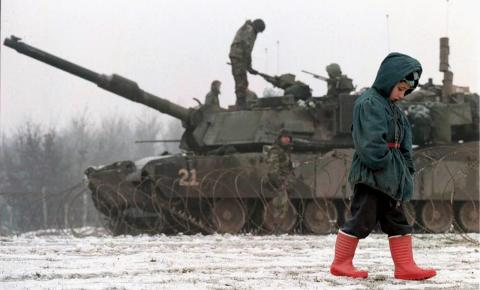There was a time when it was legitimate to wonder what NATO’s future role would be. Not anymore. If anything, the Atlantic Alliance is facing too many missions. Russia and terrorism are not the only problems: there is unfinished business in the Balkans, in Iraq and Afghanistan, as well as the migration challenge.
 NATO Heads of state and government attending the flypast in Warsaw
NATO Heads of state and government attending the flypast in Warsaw
The Summit of Heads of State and Government, held in Warsaw on 8-9 July, saw NATO enter the fourth phase of its history. The first was the Cold war; the second, peace enforcement in the Balkans; the third was the long and painful experience of Afghanistan; the fourth will see NATO mobilised, simultaneously 'in the East' and 'in the South'. In Warsaw, member States wisely avoided to debate which of these two dimensions should have the priority. In this regard, Moscow’s intervention in Syria helped.
So many things have changed in two years. The Islamic State has become a major threat. The descent into hell of Syria, instability of Afghanistan, and the collapse of Libya have produced a massive wave of migration. Russia’s intervention in Syria has connected the 'Northern' and 'Southern' problems: this means that NATO did not have to prioritise one over the other.
Despite the big European news of Brexit, the Alliance has successfully conveyed the image of unity and resolve that was needed vis-à-vis Russia. (The renewal, in June, of Ukraine-related sanctions by the European Union for another six months had been a first test, which EU members passed successfully.) No major political disagreement emerged from the closed-doors meetings in Warsaw. Overall, the (exceedingly long, even by NATO standards) Final Communiqué pushed the right buttons.
Four battalions (led by the US, UK, Canada and Germany), a total of about 4000, will be stationed in Eastern Europe; one in each of the Baltic States and one in Poland. Such presence abides by the unilateral commitment taken in the 1997 NATO-Russia Founding Act to avoid any permanent presence of substantial combat forces on the Alliance’s eastern border. It would not be able to counter a significant Russian operation: a deterrence more than a war-fighting presence, its goal would be to be a 'trip-wire'. The US decision to have permanently stationed combat troops in Poland is in this regard particularly important. [fold]
In the 'South', NATO as such is unlikely to be mobilised as such for some time. A major role for the Alliance as a collective military entity is not needed at the moment, neither in Iraq and Syria, nor in Libya. However, NATO will fly additional AWACS in the region and explore the possibility of training assistance for the Iraqi armed forces. It has decided to maintain a significant military presence in Afghanistan throughout 2017 and to continue funding for the training of the Afghan National Security Forces. It will also continue to contribute to the surveillance of migration flows (Turkish membership of the Alliance being the key reason for NATO’s role).
NATO has declared — it was an American priority — its missile defense system operational. Its legitimacy may seem weakened since the July 2015 agreement on Iran’s nuclear program IOC, but the Alliance is keen to be able to deter and defend against Tehran’s ballistic missiles, even if armed with conventional warheads.
Finally, for the first time in years, NATO – which welcomed Montenegro as soon-to-be 29th member – does not have any willing and able candidate knocking on its doorstep. Because of the new Russian attitude, Sweden and Finland are pondering a membership bid, but the debate in these two countries is far from over and there is no consensus on such a bid.
At the previous summit held in Cardiff in September 2014, the Ukrainian question had been at the forefront. Then Barack Obama had told Ukrainian president Porochenko, who had been invited to participate in a special session, that 'not one single American soldier would defend Ukraine'. Kiev signed a cease-fire with separatist forces twenty-four hours later. It was also in Cardiff that the Allies took the first 'reassurance' measures aimed at taking care of the Baltic States’ worries in light of Moscow’s aggressive attitude.
Interestingly, the NATO-Russia Council meeting that took place a few days after Warsaw Summit (only the second event since 2014), was less acrimonious than the current atmosphere between Moscow and the West would suggest.There was even a constructive — though not exceedingly ambitious —Russian proposal for a formal mechanism designed to reduce the risk of air collisions. Some would say, not without reason, that a less aggressive attitude by Russian planes, which often fly dangerously close to NATO forces, would be a prerequisite.
Proponents of a tough attitude towards Russia might see this as a vindication of the Alliance’s demonstration of resolve; but it is equally possible that Moscow was not impressed. Expect, in any case, 'counter-measures' that will likely include steps that Russia would have taken anyway, such as a reorganisation of its military presence on its Western border, or an increase in permanently stationed troops in the small Kaliningrad enclave.
Photo courtesy of NATO
